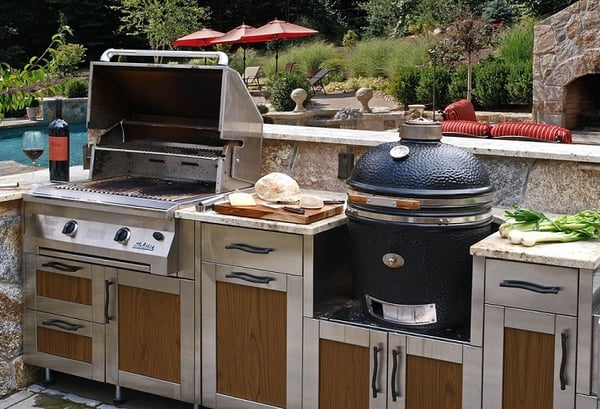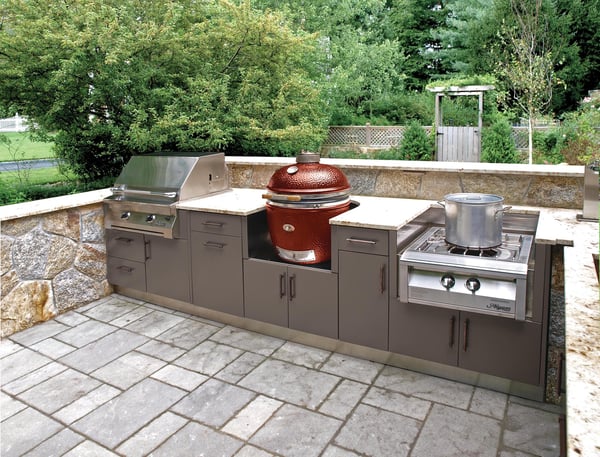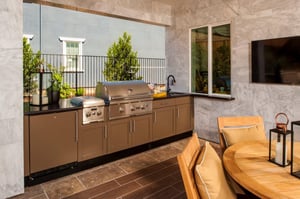
Outdoor kitchens are wonderful additions to any home. They expand the usable square footage of the property, and they allow you to get more enjoyment out of your existing space. When you opt for high-quality, element-resistant cabinetry and other accessories from brands such as Danver Outdoor Kitchens, they can even increase the resale value of the home. For these reasons, their popularity has skyrocketed over the last few years.
With their increased use, though, homeowners need to be aware of how to put in an outdoor kitchen in a safe way. Here are seven of the most important safety features to consider when you install your outdoor kitchen.
- Ensure the Gas Shut-Off Is Accessible
If you’re running elements of your outdoor kitchen on gas, be absolutely certain the shut-off valve is accessible and functional. If a leak should occur, your valve might even make it possible to just stop the gas to that specific appliance rather than to the entire kitchen. Some valves require a wrench or other tool in order to turn them. If that’s the case with your outdoor kitchen valve, ensure the proper tool is always handy or placed near the shut-off.
- Have a Fire Extinguisher at the Ready
With pizza ovens, grills, cooktop burners, and other sources of open flame and heat in your outdoor kitchen, a fire extinguisher is a must. Make sure it’s readily accessible and not expired. It’s definitely easy for the years to go by and to forget about this small item, but a fully functional fire extinguisher could be the difference between a minor scare and a big disaster! Most manufacturers say a fire extinguisher lasts about five to fifteen years. So, if it’s been a good long while since you’ve changed out your extinguisher, it might just be time.
- Don’t Forget the First Aid Kit
All the safety hazards that exist in an interior kitchen apply to exterior kitchens as well—especially if you’ve installed a fully functional food preparation and cooking area. Whether you’re dealing with an unexpected knife cut or a minor burn, it’s always a good idea to have a fully stocked and accessible first aid kit somewhere in your outdoor kitchen. If multiple people will be using your kitchen, make sure every cook knows where this is located.

- Install Safety Lighting
If there are paths leading to or from your kitchen, those should be lit with proper safety lighting. Installing lights in the risers of stairs is another must. Task lighting over cooking areas also provides an extra layer of protection. This kind of lighting helps ensure your kitchen is a safe place at all times of day, but it also enhances the usability of the space. Even when the sun goes down early in late fall, you can still utilize your kitchen without fear of anyone tripping on stairs or not being able to see what they’re doing in the kitchen. The same goes for those late summer nights when you’re entertaining family and friends.
- Opt for Nonslip Flooring
When considering the kind of flooring to install, be especially aware of slip resistance. Floors in kitchens can easily get greasy or wet, and it poses a big safety risk if that flooring is overly slick under those conditions. Especially if you have a family with young kids who are going to be running in and out of this area, the flooring needs to be nonslip.

- Strategically Place the Grill
Where you put your grill (or grills) is a vital safety decision in any kitchen. It should be a safe distance from any structure, window, door, or other dining area. This helps ensure the home doesn’t fill with smoke while you’re cooking, but it also ensures you’re in compliance with local building and fire safety codes regarding the acceptable clearance between an open flame and any combustible surface. In terms of sheer logistics, the grill shouldn’t be so close to the dining area that it restricts or limits movement between the yard and the cooking area.
- Empty Trash Bins and Clean Regularly
One potential hazard not many people consider is the risk of insects and wildlife. Depending on where you live, your outdoor kitchen could attract anything from flying annoyances to raccoons to bears. It’s essential, therefore, that you regularly empty your trash cans and keep the kitchen counters and surfaces clean of food and beverage residue. When choosing materials for your cabinetry and counters, think about what’s going to be easiest to clean. A material like stainless steel from Danver Outdoor Kitchens is easy to clean and to maintain, giving you peace of mind that you won’t be attracting any unwanted visitors!
When you’ve properly designed your outdoor kitchen and are confident every safety feature has been accounted for, you can truly enjoy what this space has to offer.
Not sure how to ensure your space is completely up to code and fully equipped with all necessary safety measures? Give us a call. We’d love to help design your outdoor living space the right way!


